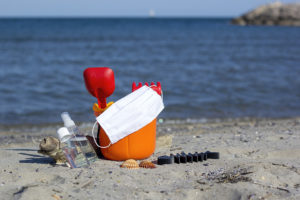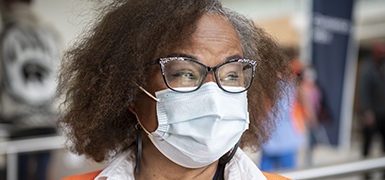
As many states’ vaccination rates increase and regulations ease, life may soon begin to resume a sense of normalcy.
Spectrum Health infectious disease doctors offer tips and advice on how to avoid a brush with COVID-19 as the summer season heats up.
Rosemary Olivero, MD, and Liam Sullivan, DO, understand well how excited people are to emerge from solitude and enjoy summertime fun. They just hope people proceed with caution.
A key thing to remember, they noted, is that outdoor activities are generally safer than indoor activities because of better air circulation and the ease of maintaining a social distance of 6 feet or more from others. Indoor areas tend to have more aerosolized droplets floating about that people may breathe in as they pass by.
If you’re unvaccinated, wearing masks whenever you’re around others is important in helping to prevent the spread of COVID-19.
As much as 40% of disease spread is from those who are infected with the virus yet show no symptoms. The droplets they release into the air when they talk, cough or sneeze may infect others around them.
Masks reduce this chance of exposure for people who have not yet been vaccinated or, like kids younger than 12, are unable to be vaccinated.
Wearing a mask may be hot and uncomfortable outdoors in the summer, so steering clear of large crowds and remaining physically distanced may be preferred as people may then be able to forego the mask outdoors.
If you and your family cannot avoid a large crowd, and are not fully vaccinated, masks are important as they are the best line of defense as people seek to safely enjoy the world outside their front doors.
Another factor to consider is the size of gatherings.
“If your summertime activities involve family and friends, try to keep your social circle tight and limited to those you believe also are being cautious,” Dr. Sullivan said, or better yet, keep it to those who are also vaccinated. “The wider your social circle, the more likely you are to be exposed.”
Top 10 summertime activities, ranked from lowest to highest risk:
10. Staying in a hotel
If you avoid crowds in lobbies or eating areas, the risk is low. If you’re unvaccinated, wear a mask when checking in and leaving your room, Dr. Sullivan said.
Also consider wiping down or spraying hard surfaces you might touch with disinfectant. This includes door knobs, remote controls, light switches, faucets, countertops and bedside tables.
9. Going camping
Enjoy the great outdoors with low risk, particularly if you camp as a family unit or among others who are vaccinated.
“Incorporating other friends or families increases the risk so practice social distancing as much as possible,” Dr. Sullivan said.
8. Going to a public pool or the beach
Swimming and summer are almost synomynous. Good news here—you are unlikely to contract the virus in the water. If you practice social distancing, this is an activity that poses a low risk.
“But steer clear if your beach or pool of choice is crowded,” Dr. Sullivan said.
Perhaps enjoy a swim in the early morning or walk and lounge on the beach in the evening when fewer people are present.
7. Attending day camps or visiting playgrounds
Outdoor activities in small groups pose a relatively low risk if social distancing is in effect.
“Ask camp organizers how they will enforce social distancing,” Dr. Olivero advised.
Also, be sure to wash your hands or use hand sanitizer after a visit to a playground.
6. Using a public restroom
Public restrooms present a low to medium risk, particularly if they are cleaned often.
Larger restrooms inside establishments are likely to have better sanitation and ventilation rather than small portable units or restrooms that are outside gas stations. Mask-wearing is suggested, particularly for people who are unvaccinated.
“As always, wash your hands and avoid touching many surfaces,” Dr. Sullivan said.
5. Dining at home with friends
A dinner at home with friends poses a low to medium risk if you eat outdoors and keep the numbers low.
Think about spacing your guests out and not sharing appetizers. The risk increases if you move the meal indoors, particularly if you or your party includes friends or family who have not yet received a vaccine.
“Risk also grows if your guests stick around for several hours,” Dr. Sullivan said.
4. Weekend trip with another family
Time away with another unvaccinated family poses a medium risk. If both of your families are vaccinated, this risk is low.
“The risk level varies depending upon the size of the group and how much time everyone spends in close proximity,” Dr. Olivero said. “Reduce the risk by connecting with families who have been exercising caution.”
3. Dining in a restaurant
Just like dining at home with friends, outdoor dining is less risky than indoor dining. Dining indoors, particularly if the restaurant is busy, presents a medium to high risk due to concerns about poor ventilation and proximity to others.
Fully vaccinated people should still exercise caution around crowds and while going into bars or restaurants, Dr. Sullivan said.
“They can choose not to wear a mask, but they also need to understand there remains a potential risk for infection despite vaccination,” he said.
2. Visiting an amusement park
“Amusement parks are generally synonymous with large crowds,” Dr. Olivero said.
So, if you can’t be assured capacity is greatly limited and that, when crowded, masks would be worn by unvaccinated people, you may consider this activity high risk.
1. Hitting the bars
Going to a bar is a high-risk activity due to crowds, loud talking (which emits more droplets into the air), your inability to wear a mask and the difficulty of social distancing.
“Bars also have lots of high-touch surfaces and patrons aren’t likely to be frequently sanitizing or washing their hands,” Dr. Sullivan said.

 /a>
/a>
 /a>
/a>
 /a>
/a>